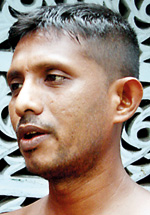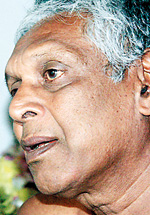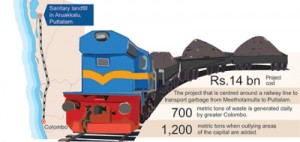News
Residents hope for miracle from candidates who talk ‘rubbish’
The accumulating heaps of garbage in Meethotamulla, a major dumping site for the Western Province, has reached a point where people in the vicinity struggle to live a normal life while officials point fingers at each another, more than a decade after the crisis was predicted.

Controversial issue:Garbage dump in Meethotamulla. Pix by Indika Handuwala
Colombo City has being struggling to dispose of its daily garbage in a sustainable manner. The former government pushed on with beautifying the country’s capital while in the shadows the residents of Meethotamulla called in vain for officials to take Colombo’s garbage away from their backyard.
The stink of the dumping yard reaches unbearable levels, while politicians are still making use of the issue to gain votes by making repeated empty promises to the residents, promising to resolve the issue in the “near future”.Udagedara Padmalatha, 28, a mother of three and expecting her fourth and a resident of Dahampura in Meethotamulla, is hopeful that the current promises being made by candidates for next month’s general election would at last bear fruit.

Rasika Sanjeewa
“Every morning my children wake up to a garbage mountain. This is affecting their mentality and reduced their productivity in school,” she lamented, adding that the children were frequently ill. On May 24, a large number of villagers launched a protest demanding the removal of the garbage site. The action obstructed traffic on the Avissawella-Colombo road when they burned tyres in the middle of the road. Police used water cannon to disperse the crowd.
“The villagers took this action because it is unbearable to live in these conditions,” said the convener of the People’s Movement against the Meethotamulla Garbage Dump (PMMGD) Keerthirathna Perera.Mr. Perera, 64, who built his house in Meethotamulla in the 1980s, said that the problem began in 2003 and worsened around 2009 when the Colombo Municipal Council (CMC) began trucking in garbage under the direction of the Urban Development Authority (UDA) following the closure of the Bloemendhal dumping site which previously accommodated Colombo’s waste.
Now, around 1200 metric tonnes of both degradable and biodegradable waste are dumped in Meethotamulla daily while Rs. 600-700 million is spent monthly to maintain the dump.This is when the Meethotamulla residents started to launch a series of protests in a bid to stall the CMC from bringing in any more garbage.

Keerthirathna Perera
“In early 2012, we went to ministers and concerned officials begging them to stop invading our lives. We explained to them how our people are dying and children are falling sick but no one paid us any heed,” Mr. Perera said.The garbage disposal has posed dire consequences that the Colombo Municipal Council (CMC), UDA, and the Central Environmental Authority (CEA) had probably not anticipated. Mosquitoes, fleas and rodents plague the vicinity; rain waters overflows clogged waterways and the polluted water gushes into homes while methane gas emitted from the dump causes respiratory problems to residents.
If the situation was bad then it is worse now. In Dahampura, at Rasika Sanjeewa’s house, his two little sons play ball. His daughter who has just returned from school kicks her shoes off and runs to join her brothers. Next to them sleep stray dogs with ticks eating into their flesh. A crow from a tree drops a chicken head from the tip into a clogged drain while the stink of the disposal encircles them, made worse by the wind.
“This is our life now. I’m a father and like to see my children in a cleaner place but where can we go? This is our home,” said Mr. Sanjeewa. His house bears cracks from the weight of the garbage on the nearby site, and one room is flooded. The house is uninhabitable. Until the authorities provide a solution Mr. Sanjeewa has shifted his family into a room where they cooked and slept.
UDA Deputy Project Director Prasad Ranaweera said the authority was not at fault. He claimed that the CMC began the problem when it failed to identify a proper site for dumping Colombo’s garbage. “We only allowed the CMC to dump the garbage for two years and also only in two acres but now it has exceeded 17 acres,” Mr. Ranaweera said.
 Last year, the UDA took over a Rs. 14 billion ($107 million), project to transport waste via rail to a nearly 300 acre site in Arakkalu in Puttalam. The plan was to fill large pits that had been dug to mine limestone for the manufacture of cement.
Last year, the UDA took over a Rs. 14 billion ($107 million), project to transport waste via rail to a nearly 300 acre site in Arakkalu in Puttalam. The plan was to fill large pits that had been dug to mine limestone for the manufacture of cement.
“The project will take at least two years to be implemented. The Environmental Impact Assessment of it is in the final phrase. After that, tenders will be invited. Till then as an alternative solution, under the direction of the Prime Minister, we have called for private projects,” Mr. Ranaweera said.
He added that the UDA had received 60 such proposals which would be evaluated by three committees including university professors, ministers, solid waste sector committees and other experts.Mr. Ranaweera also said that, as the dump grew, more than 200 families had to be rehomed away from the vicinity. “We can’t expand any more and we have decided to demarcate a 20m buffer zone to protect the other residents,” he added.
CEA Chairman Professor Lal Dharmasiri said more than 20 government institutions were working together to resolve the issue.
But the local people cannot wait any longer. According to Danthanarayana Dudley, 66, father of three and a resident of Dahampura for 35 years, the worst affected are those with deeds to their land. He said their houses have been damaged by the mounting of waste but the government had failed to find a favourable solution for them.
CMC Commissioner U.K.A. Anura said the dump was not a “huge issue yet” but would get worse. Naming it a “national problem”, Mr. Anura agreed there was no spare capacity at the site. “For the people who were affected so far we have given compensation to 275 families. All of them were unauthorised dwellers. We have given houses to 158 families while others were given Rs. 1.5 million to move,” he said, adding that the measures had been taken in consultation with these people. “If a house belonging to a person who has a deed to the property is broken we will take action to repair it,” he said.
| Meethotamulla must endure until Puttalam yard ready The dumping sites in Meethotamulla and Karadiyana are full, capacities have been exceeded and cannot be managed any longer, Colombo Municipal Council (CMC) Solid Waste Management Engineering Director Anjali Devaraja said. She stressed there was no other alternative but to transport Colombo garbage across the country to Puttalam.“The project was not delayed by us but since there is a new government, there is a new system and it is taking time to adapt to that,” Ms. Devaraja said, adding that however, the Puttalam project was economically viable, environmentally friendly and had not been found to be at fault. She explained that incineration of garbage was costly at about Rs. 4000 ($30) per tonne and would not work in any case because the waste was wet.“Even waste-to-energy projects have failed,” she said adding that till the Puttalam yard was ready there was no other option but to continue dumping garbage in Meethotamulla. | |
| Most children in area suffer from skin diseases Research by local doctors found 60 per cent of the children living in the vicinity of the Meethotamulla garbage dump have skin diseases and 65 per cent have respiratory issues.The research, carried out in 2013, found 30 local residents had died from dengue while 400 suspected cases of the illness had been reported from the area, and that rat fever and kidney failure were present. “Almost all wells in the area are unusable and making matters worse any clothes that are washed and put out to dry have an unpleasant stench,” a lawyer attached to the People’s Movement against the Meethotamulla Garbage Dump, Nuwan Bopage, said. Mr. Bopage accused the Colombo Municipal Council of ignoring the issue as it was receiving commissions from private companies that transport waste to the dump. |

